-
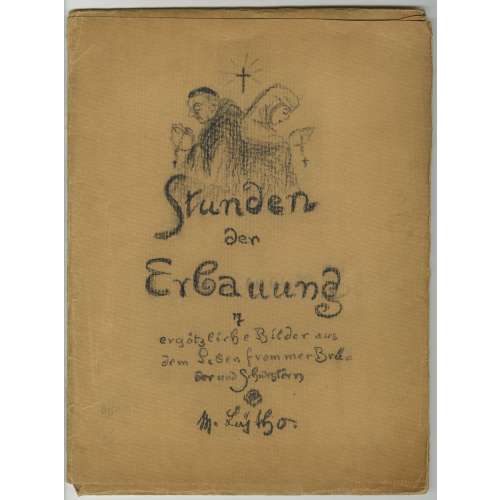 Flapped folder of thick embossed paper 353 x 263 mm, with a vignette and manuscript to front: Stunden der Erbauung | 7 | ergötz liebe Bilder aus | dem Leben frommer Brü | der und Schwestern | • | M. Leÿtho. ||, six graphite pencil drawings, each glued to a paper sheet with guard tissue; mat size 339 x 253 mm mat; drawing size 220 x 165 mm. Translation of the title: Hours of Edification / 7 delightful pictures from the lives of pious brothers and sisters. Information about the artist at www.honesterotica.com: "Mitja Leytho, almost certainly a pseudonym, is yet another mediocre yet fascinating amateur artist from the Germany of the 1920s about whom we know absolutely nothing beyond the four portfolios which bear the ‘Leytho’ signature".
Flapped folder of thick embossed paper 353 x 263 mm, with a vignette and manuscript to front: Stunden der Erbauung | 7 | ergötz liebe Bilder aus | dem Leben frommer Brü | der und Schwestern | • | M. Leÿtho. ||, six graphite pencil drawings, each glued to a paper sheet with guard tissue; mat size 339 x 253 mm mat; drawing size 220 x 165 mm. Translation of the title: Hours of Edification / 7 delightful pictures from the lives of pious brothers and sisters. Information about the artist at www.honesterotica.com: "Mitja Leytho, almost certainly a pseudonym, is yet another mediocre yet fascinating amateur artist from the Germany of the 1920s about whom we know absolutely nothing beyond the four portfolios which bear the ‘Leytho’ signature". -
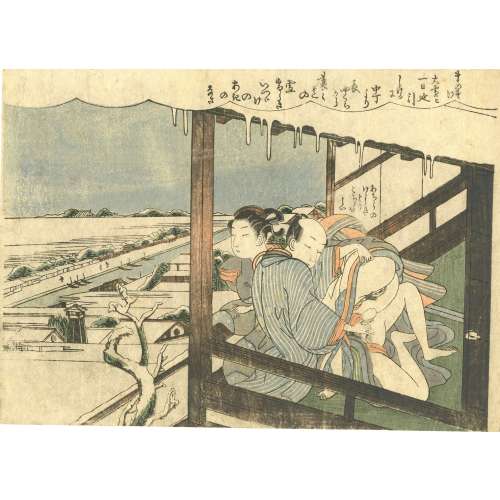 Unsigned print, attributed to Suzuki Harunobu. Erotic scene on open veranda with a winter landscape on background.
Unsigned print, attributed to Suzuki Harunobu. Erotic scene on open veranda with a winter landscape on background. -
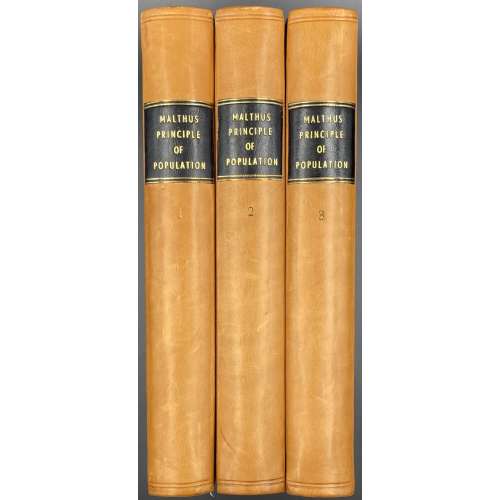 Title: AN ESSAY | ON THE | PRINCIPLE OF POPULATION; | OR, | A VIEW OF ITS PAST AND PRESENT EFFECTS | ON | HUMAN HAPPINESS; | WITH | AN INQUIRY INTO OUR PROSPECTS RESPECTING THE FUTURE | REMOVAL OR MITIGATION OF THE EVILS WHICH | IT OCCASIONS | BY T. R. MALTHUS, A. M. | Late Fellow of Jesus College, Cambridge, and Professor of History and Political Economy in the East-India College, Hertfordshire. | IN THREE VOLUMES. | VOL. I. [or II. or III.] | THE FIFTH EDITION, | WITH IMPORTANT ADDITIONS. | LONDON: | JOHN MURRAY, ALBEMARLE-STREET. | 1817. || Pagination and collation: Vol. 1: ffl, [i, ii] – t. p. / imprint., [iii] iv-xvi, [1] 2-496, bfl; A-Z8 2A-2I8. Vol. 2: ffl, [i, ii] – t. p. / imprint., [iii]-iv – contents, [1]-2-507 [508], bfl; [A]2 B-Z8 2A-2I8 2K6. Vol. 3: ffl, [i, ii] – t. p. / imprint., [iii]-iv – contents, [1]-2-500, bfl; [A]2 B-Z8 2A-2I8 2K2. Binding: Three volumes printed on wove paper, uniformly bound in quarter brown polished calf, blind-ruled, black label, ruled and lettered in gilt to spine, green buckram boards; 22.2 x 13.5 cm. Edition: 5th edition, corrected with a new preface, an updated appendix of Malthus’ responses to his critics, and addition of several chapters to the whole: on France, England, and on the poor laws. Lifetime edition. Ref.: Einaudi 3670; Goldsmiths’ 21761; Kress B.6974; Mattioli 2210. Printed by W. Clowes: William Clowes Ltd. (London). Clowes, William (British, 1779 – 1847). Malthus, Thomas Robert (British, 1766 – 1834). Murray, John (British, 1737 – 1793) Murray, John II (British, 1778 – 1843) John Murray (publishing house)
Title: AN ESSAY | ON THE | PRINCIPLE OF POPULATION; | OR, | A VIEW OF ITS PAST AND PRESENT EFFECTS | ON | HUMAN HAPPINESS; | WITH | AN INQUIRY INTO OUR PROSPECTS RESPECTING THE FUTURE | REMOVAL OR MITIGATION OF THE EVILS WHICH | IT OCCASIONS | BY T. R. MALTHUS, A. M. | Late Fellow of Jesus College, Cambridge, and Professor of History and Political Economy in the East-India College, Hertfordshire. | IN THREE VOLUMES. | VOL. I. [or II. or III.] | THE FIFTH EDITION, | WITH IMPORTANT ADDITIONS. | LONDON: | JOHN MURRAY, ALBEMARLE-STREET. | 1817. || Pagination and collation: Vol. 1: ffl, [i, ii] – t. p. / imprint., [iii] iv-xvi, [1] 2-496, bfl; A-Z8 2A-2I8. Vol. 2: ffl, [i, ii] – t. p. / imprint., [iii]-iv – contents, [1]-2-507 [508], bfl; [A]2 B-Z8 2A-2I8 2K6. Vol. 3: ffl, [i, ii] – t. p. / imprint., [iii]-iv – contents, [1]-2-500, bfl; [A]2 B-Z8 2A-2I8 2K2. Binding: Three volumes printed on wove paper, uniformly bound in quarter brown polished calf, blind-ruled, black label, ruled and lettered in gilt to spine, green buckram boards; 22.2 x 13.5 cm. Edition: 5th edition, corrected with a new preface, an updated appendix of Malthus’ responses to his critics, and addition of several chapters to the whole: on France, England, and on the poor laws. Lifetime edition. Ref.: Einaudi 3670; Goldsmiths’ 21761; Kress B.6974; Mattioli 2210. Printed by W. Clowes: William Clowes Ltd. (London). Clowes, William (British, 1779 – 1847). Malthus, Thomas Robert (British, 1766 – 1834). Murray, John (British, 1737 – 1793) Murray, John II (British, 1778 – 1843) John Murray (publishing house) -
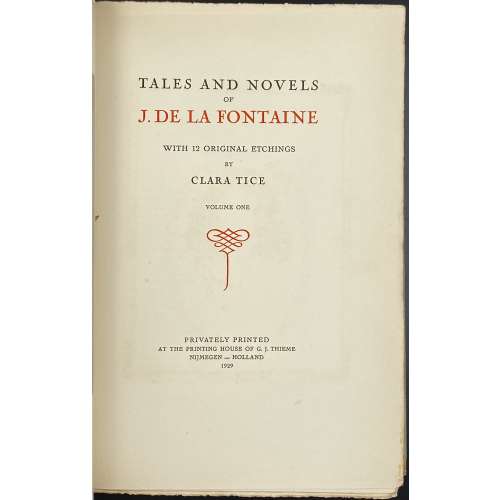 Title-page (in red and black): TALES AND NOVELS | OF | J. DE LA FONTAINE | WITH 12 ORIGINAL ETCHINGS | BY | CLARA TICE | VOLUME ONE (TWO) | {arabesque} | PRIVATELY PRINTED | AT THE PRINTING HOUSE OF G. J. THIEME | NIJMEGEN ~ HOLLAND | 1929 || Collation: 8vo. Vol. 1: π8 (2 blanks, h.t. / limitation №103 of 990, frontispiece etched portrait of La Fontaine w/ tissue guard, 4 leaves uncut with table and preface), 1—138, incl. 2 final blanks, paginated: xvi, 204 [4], plus 5 etchings besides frontis., all with tissue guards, by Clara Tice, in sepia. Vol. 2: π8, 1-188, paginated: xvi, 270 [271] epitaph, [272] blank, plus 6 etchings w/ tissue guards, by Clara Tice. Binding: 25.3 x 16.8 cm, quarter faux parchment over light blue publisher's boards, gilt lettering to spine. Ticket to front pastedown in each volume: “FROM THE COLLECTION | OF PRINCETON ANTIQUES BOOKFINDERS”, etc. Etchings printed on wove paper, text – on laid paper; untrimmed, uncut. Edition: limited, privately printed run of 990 copies of which this is №103.
Title-page (in red and black): TALES AND NOVELS | OF | J. DE LA FONTAINE | WITH 12 ORIGINAL ETCHINGS | BY | CLARA TICE | VOLUME ONE (TWO) | {arabesque} | PRIVATELY PRINTED | AT THE PRINTING HOUSE OF G. J. THIEME | NIJMEGEN ~ HOLLAND | 1929 || Collation: 8vo. Vol. 1: π8 (2 blanks, h.t. / limitation №103 of 990, frontispiece etched portrait of La Fontaine w/ tissue guard, 4 leaves uncut with table and preface), 1—138, incl. 2 final blanks, paginated: xvi, 204 [4], plus 5 etchings besides frontis., all with tissue guards, by Clara Tice, in sepia. Vol. 2: π8, 1-188, paginated: xvi, 270 [271] epitaph, [272] blank, plus 6 etchings w/ tissue guards, by Clara Tice. Binding: 25.3 x 16.8 cm, quarter faux parchment over light blue publisher's boards, gilt lettering to spine. Ticket to front pastedown in each volume: “FROM THE COLLECTION | OF PRINCETON ANTIQUES BOOKFINDERS”, etc. Etchings printed on wove paper, text – on laid paper; untrimmed, uncut. Edition: limited, privately printed run of 990 copies of which this is №103. -
![[ROSCOE, Thomas, translator]. Tales of Humour, Gallantry, & Romance, selected and translated from the Italian. With sixteen illustrative Drawings by George Cruikshank. London, Printed for Charles Baldwyn, 1827.](https://varshavskycollection.com/wp-content/uploads/2021/02/LIB-1079-2-scaled-500x500.jpg) Title: TALES | OF | Humour, Gallantry, & Romance, | SELECTED AND TRANSLATED | FROM THE ITALIAN. | Vignette "The Elopement, p. 183" | With sixteen illustrative Drawings by George Cruikshank. | — | LONDON : | PRINTED FOR CHARLES BALDWYN, | NEWGATE STREET. | MDCCCXXVII. Pagination: [2], [v]-vi [2] – Contents (Cohn's collation calls for this at the end) 3-253, [1]; title-page a cancel with vignette 'The Elopment', sixteen other plates by Cruikshank; as per HathiTrust: vi, 253, [3] p. (last p. blank), [16] leaves of plates: ill. Binding: 8vo, 20 x 13 cm, later polished calf, gilt, t.e.g. others untrimmed, by Rivière for H. Sotheran. Note: 1st edition, very rare 3rd issue, with a cancel title-page replacing that of 1824 issue when there were two issues and the work was entitled Italian Tales. Cohn notes the rarity of the 1827 edition, which restores one of the plates 'The Dead Rider', suppressed in the second issue, and also includes the plate done to replace it. "The rarest edition of this work is that published in 1827 in green paper boards [...]. This issue has no edition stated on the title. It has seventeen woodcuts, inclusive of the "Elopement" vignette upon the title. The suppressed plate "The Dear Rider" is restored, and the plate done to replace it is also included. The woodcut in other editions upon the title page is "The Pomegranate Seed". Probably compiled and translated by Thomas Roscoe (cf. National union catalog) from a variety of authors 'out of materials not generally accessible', but also ascribed to J. Y. Akerman and to one "Southern". Two or three tales that furnished plots for Shakespeare. Catalogue Raisonné: Cohn 444; this issue not found in OCLC or COPAC.
Title: TALES | OF | Humour, Gallantry, & Romance, | SELECTED AND TRANSLATED | FROM THE ITALIAN. | Vignette "The Elopement, p. 183" | With sixteen illustrative Drawings by George Cruikshank. | — | LONDON : | PRINTED FOR CHARLES BALDWYN, | NEWGATE STREET. | MDCCCXXVII. Pagination: [2], [v]-vi [2] – Contents (Cohn's collation calls for this at the end) 3-253, [1]; title-page a cancel with vignette 'The Elopment', sixteen other plates by Cruikshank; as per HathiTrust: vi, 253, [3] p. (last p. blank), [16] leaves of plates: ill. Binding: 8vo, 20 x 13 cm, later polished calf, gilt, t.e.g. others untrimmed, by Rivière for H. Sotheran. Note: 1st edition, very rare 3rd issue, with a cancel title-page replacing that of 1824 issue when there were two issues and the work was entitled Italian Tales. Cohn notes the rarity of the 1827 edition, which restores one of the plates 'The Dead Rider', suppressed in the second issue, and also includes the plate done to replace it. "The rarest edition of this work is that published in 1827 in green paper boards [...]. This issue has no edition stated on the title. It has seventeen woodcuts, inclusive of the "Elopement" vignette upon the title. The suppressed plate "The Dear Rider" is restored, and the plate done to replace it is also included. The woodcut in other editions upon the title page is "The Pomegranate Seed". Probably compiled and translated by Thomas Roscoe (cf. National union catalog) from a variety of authors 'out of materials not generally accessible', but also ascribed to J. Y. Akerman and to one "Southern". Two or three tales that furnished plots for Shakespeare. Catalogue Raisonné: Cohn 444; this issue not found in OCLC or COPAC. -
 Hardcover volume, 22.5 x 15 cm, bound in red cloth with gilt lettering to spine, pictorial dust jacket; pp.: [i-v] vi-xiv, [1-5] 6-251 [252], total 268 pages. Title-page: Alleged sex and threatened violence | Doctor Russel, Bishop Vladimir, and the Russians in | San Francisco, 1887-1892 | TERENCE EMMONS | — | Stanford University Press | Stanford, California | 1977 || ISBN: 9780804727679, 9780804727686, 0804727678, 0804727686. OCLC Number / Unique Identifier: 35159156. Doctor Nikolai Sudzilovsky [Nicholas Russel] (Belarusian, 1850 – 1930). Bishop Vladimir (Sokolovsky-Avtonomov, Vasily Grigorievich) Архиепископ Владимир (Соколовский-Автономов, Василий Григорьевич) (Russian, 1852 – 1931) – Archbishop of the Aleutians and Alaska.
Hardcover volume, 22.5 x 15 cm, bound in red cloth with gilt lettering to spine, pictorial dust jacket; pp.: [i-v] vi-xiv, [1-5] 6-251 [252], total 268 pages. Title-page: Alleged sex and threatened violence | Doctor Russel, Bishop Vladimir, and the Russians in | San Francisco, 1887-1892 | TERENCE EMMONS | — | Stanford University Press | Stanford, California | 1977 || ISBN: 9780804727679, 9780804727686, 0804727678, 0804727686. OCLC Number / Unique Identifier: 35159156. Doctor Nikolai Sudzilovsky [Nicholas Russel] (Belarusian, 1850 – 1930). Bishop Vladimir (Sokolovsky-Avtonomov, Vasily Grigorievich) Архиепископ Владимир (Соколовский-Автономов, Василий Григорьевич) (Russian, 1852 – 1931) – Archbishop of the Aleutians and Alaska. -
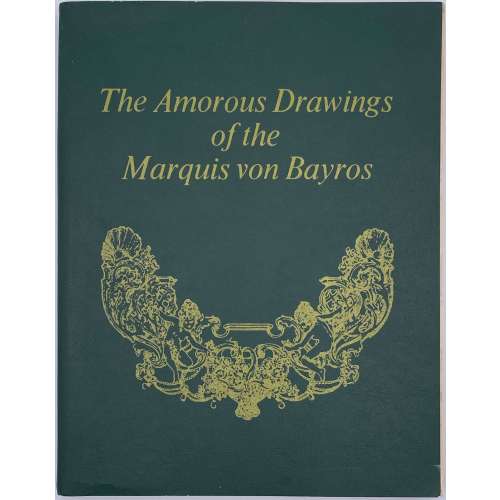 Title: The amorous drawings | {vignette} | of the | Marquis von Bayros | Part I | BRANDON HOUSE | NORTH HOLLYWOOD || Title page verso: A BRANDON HOUSE BOOK | PUBLISHED BY ARRANGEMENT WITH | CYTHERA PRESS | COPYRIGHT 1968 BY CYTHERA PRESS | ALL RIGHTS RESERVED. | MANUFACTURED IN THE UNITED STATES OF AMERICA || Pagination: [1-3] 4-238 [2], 292 illustrations within pagination. Content: Preface by Wilhelm M. Busch, biography of Von Bayros by Johann Pilz, two essays by Von Bayros; 292 illustrations by Marquis Franz von Bayros; Part I and II in one volume. Exterior: 28 x 22 cm, publisher's green wrappers with yellow lettering and fac-simile drawing of von Bayros to cover, lettering to spine. A re-print softcover edition of the original Cythera Press 1st edition, see: LIB-2246.2019
Title: The amorous drawings | {vignette} | of the | Marquis von Bayros | Part I | BRANDON HOUSE | NORTH HOLLYWOOD || Title page verso: A BRANDON HOUSE BOOK | PUBLISHED BY ARRANGEMENT WITH | CYTHERA PRESS | COPYRIGHT 1968 BY CYTHERA PRESS | ALL RIGHTS RESERVED. | MANUFACTURED IN THE UNITED STATES OF AMERICA || Pagination: [1-3] 4-238 [2], 292 illustrations within pagination. Content: Preface by Wilhelm M. Busch, biography of Von Bayros by Johann Pilz, two essays by Von Bayros; 292 illustrations by Marquis Franz von Bayros; Part I and II in one volume. Exterior: 28 x 22 cm, publisher's green wrappers with yellow lettering and fac-simile drawing of von Bayros to cover, lettering to spine. A re-print softcover edition of the original Cythera Press 1st edition, see: LIB-2246.2019 -
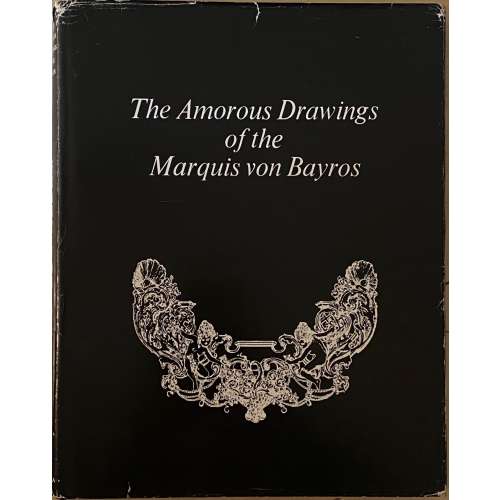 Title: The amorous drawings | of the | Marquis von Bayros | Part I | THE CYTHERA PRESS | NEW YORK Pagination: [1-3] 4-238 [2], 292 illustrations within pagination. Content: Preface by Wilhelm M. Busch, biography of Von Bayros by Johann Pilz, two essays by Von Bayros; 292 illustrations by Marquis Franz von Bayros; Part I and II in one volume. Exterior: 33 x 26 cm, publisher's black cloth with white lettering and fac-simile drawing of von Bayros to cover, white lettering to spine, similarly designed DJ. The original Cythera Press hardcover edition of 1968.
Title: The amorous drawings | of the | Marquis von Bayros | Part I | THE CYTHERA PRESS | NEW YORK Pagination: [1-3] 4-238 [2], 292 illustrations within pagination. Content: Preface by Wilhelm M. Busch, biography of Von Bayros by Johann Pilz, two essays by Von Bayros; 292 illustrations by Marquis Franz von Bayros; Part I and II in one volume. Exterior: 33 x 26 cm, publisher's black cloth with white lettering and fac-simile drawing of von Bayros to cover, white lettering to spine, similarly designed DJ. The original Cythera Press hardcover edition of 1968. -
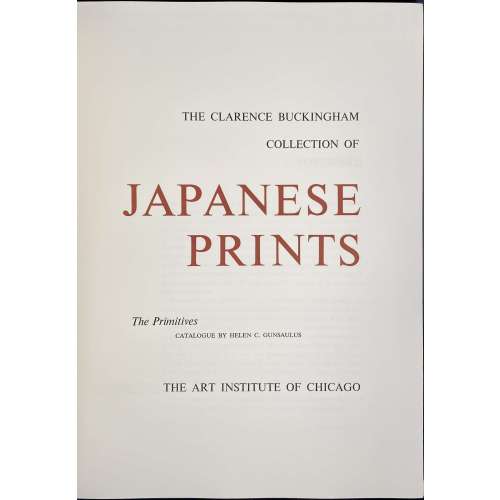 Two volumes, each bound in red cloth with gilt lettering to spine, black endpapers, TEG, and matching red cloth slipcases with black lettering to front. Vol. 1: The Clarence Buckingham collection of Japanese prints: The Primitives / Catalogue by Helen C. Gunsaulus. — [Chicago]: Art Institute of Chicago, 1955. Pagination: 1st leaf blank, 2nd leaf half-title, verso blank, [i, ii] – t.p. in red and black, copyright to verso, iii-vi, [vii] faux-title “The catalogue”, 1-284 [285] colophon, limitation: 500 numbered copies, this is № 476. Title-page: THE CLARENCE BUCKINGHAM | COLLECTION OF | JAPANESE PRINTS | The Primitives | CATALOGUE BY HELEN C. GUNSAULUS | THE ART INSTITUTE OF CHICAGO || Vol. 2: The Clarence Buckingham collection of Japanese prints: Volume 2 / Catalogue by Margaret O. Gentles. — [Chicago]: Art Institute of Chicago, 1965. Pagination: 1st leaf blank, 2nd leaf half-title, verso blank, [i, ii] – t.p. in red and black, copyright to verso, iii-vi, [vii] faux-title “The catalogue”,1-307 [2] blank/ colophon, limitation: 1000 copies (unnumbered). Title-page: VOLUME II | THE CLARENCE BUCKINGHAM | COLLECTION OF | JAPANESE PRINTS | Harunobu, Koryūsai, Shigemasa, their followers and contemporaries | Catalogue by Margaret O. Gentles | THE ART INSTITUTE OF CHICAGO 1965 || Contributors: Clarence Buckingham (American, 1854 – 1913) Helen C. Gunsaulus (American, 1886 – 1954) Margaret O. Gentles (American, 1905 – 1969)
Two volumes, each bound in red cloth with gilt lettering to spine, black endpapers, TEG, and matching red cloth slipcases with black lettering to front. Vol. 1: The Clarence Buckingham collection of Japanese prints: The Primitives / Catalogue by Helen C. Gunsaulus. — [Chicago]: Art Institute of Chicago, 1955. Pagination: 1st leaf blank, 2nd leaf half-title, verso blank, [i, ii] – t.p. in red and black, copyright to verso, iii-vi, [vii] faux-title “The catalogue”, 1-284 [285] colophon, limitation: 500 numbered copies, this is № 476. Title-page: THE CLARENCE BUCKINGHAM | COLLECTION OF | JAPANESE PRINTS | The Primitives | CATALOGUE BY HELEN C. GUNSAULUS | THE ART INSTITUTE OF CHICAGO || Vol. 2: The Clarence Buckingham collection of Japanese prints: Volume 2 / Catalogue by Margaret O. Gentles. — [Chicago]: Art Institute of Chicago, 1965. Pagination: 1st leaf blank, 2nd leaf half-title, verso blank, [i, ii] – t.p. in red and black, copyright to verso, iii-vi, [vii] faux-title “The catalogue”,1-307 [2] blank/ colophon, limitation: 1000 copies (unnumbered). Title-page: VOLUME II | THE CLARENCE BUCKINGHAM | COLLECTION OF | JAPANESE PRINTS | Harunobu, Koryūsai, Shigemasa, their followers and contemporaries | Catalogue by Margaret O. Gentles | THE ART INSTITUTE OF CHICAGO 1965 || Contributors: Clarence Buckingham (American, 1854 – 1913) Helen C. Gunsaulus (American, 1886 – 1954) Margaret O. Gentles (American, 1905 – 1969) -
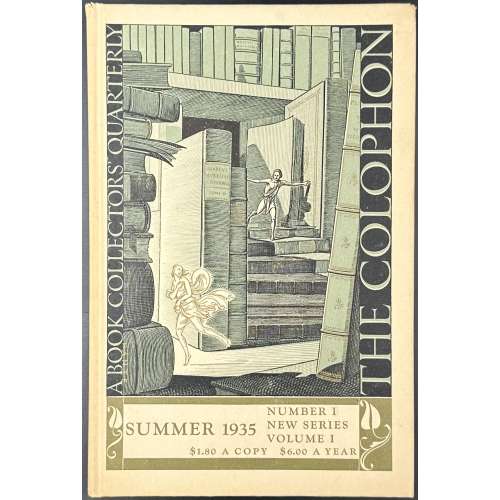
The Colophon, A Book Collectors' Quarterly
- The colophon (new series): A quarterly for bookmen / Summer 1935, № 1, vol. 1. — NY: Pynson Printers, 1935. Hardcover, 24 x 16 cm, paper boards, serial pictorial design; pp: [4 blanks] [6] 7-159 [160] [4 blanks]. THE | COLOPHON | new series | A QUARTERLY FOR BOOKMEN | {woodcut vignette} | — | SUMMER 1935 | VOLUME I • NEW SERIES • NUMBER 1 | NEW YORK, N. Y. ||
- The colophon (new series): A quarterly for bookmen / Autumn 1935, № 2, vol. 1. — NY: Pynson Printers, 1935. (2 copies). Hardcover, 24 x 16 cm, paper boards, serial pictorial design; pp: [4 blanks] [6] 167-315 [315] [4 blanks]. THE | COLOPHON | new series | A QUARTERLY FOR BOOKMEN | {woodcut vignette} | — | AUTUMN 1935 | VOLUME I • NEW SERIES • NUMBER 2 | NEW YORK ||
- The colophon (new series): A quarterly for bookmen / Autumn 1936, № 1, vol. 2. — NY: Pynson Printers, 1936. Hardcover, 24 x 16 cm, cloth serial design; pp: [4 blanks] [6] 7-157 [158] [4 blanks]. THE | COLOPHON | new series | A QUARTERLY FOR BOOKMEN | {woodcut vignette} | — | AUTUMN 1936 | VOLUME II • NEW SERIES • NUMBER 1 | NEW YORK ||
- The colophon (new series): A quarterly for bookmen / Winter 1936, № 3, vol. 1. — NY: Pynson Printers, 1936. (2 copies) Hardcover, 24 x 16 cm, paper boards, serial pictorial design; pp: [4 blanks] [6] 323-480 [4 blanks]. THE | COLOPHON | new series | A QUARTERLY FOR BOOKMEN | {woodcut vignette} | — | WINTER 1936 | VOLUME I • NEW SERIES • NUMBER 3 | NEW YORK ||
- The colophon (new series): A quarterly for bookmen / Autumn 1937, № 4, vol. 2. — NY: Pynson Printers, 1937. Hardcover, 24 x 16 cm, cloth serial design; pp: [4 blanks] [6] 487-628 [4 blanks]. THE | COLOPHON | new series | A QUARTERLY FOR BOOKMEN | {woodcut vignette} | — | AUTUMN 1937 | VOLUME II • NEW SERIES • NUMBER 4 | NEW YORK ||
- The colophon (new series): A quarterly for bookmen / Summer 1938, № 3, vol. 3. — NY: Pynson Printers, 1938. Hardcover, 24 x 16 cm, cloth new serial design; pp: [4 blanks] [6] 335-476 [4 blanks]. THE | COLOPHON | new series | A QUARTERLY FOR BOOKMEN | {woodcut vignette} | — | SUMMER 1938 | VOLUME III • NEW SERIES • NUMBER 3 | NEW YORK ||
- The colophon (new series): A quarterly for bookmen / Autumn 1938, № 4, vol. 3. — NY: Pynson Printers, 1938. Hardcover, 24 x 16 cm, cloth new serial design; pp: [4 blanks] [6] 483-632 [4 blanks]. THE | COLOPHON | new series | A QUARTERLY FOR BOOKMEN | {woodcut vignette} | — | AUTUMN 1938 | VOLUME III • NEW SERIES • NUMBER 4 | NEW YORK ||
-
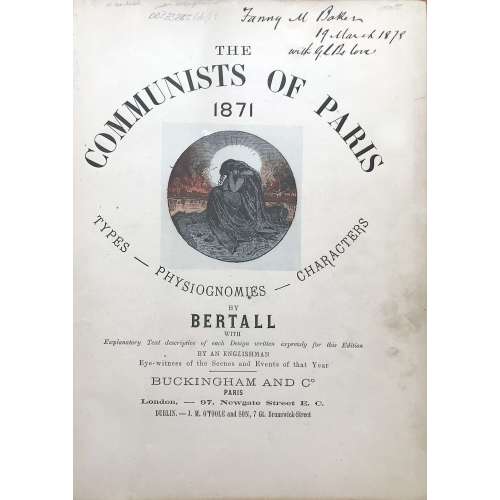 Folio (246 x 321 mm), hardbound in red-brown cloth with gilt lettering and decoration. Content, Introduction by J. E., September, 1873, Artist preface by Bertall, Paris, 1871-1873. Album with 40 hand-colored lithographs by Bertall, numbered 1 through 40, accompanied with extensive descriptions. Ex Libris: Baker. Carpe Diem. Markings: Janny M. Baker with J.L.B. Love, 19 March, 1878 in black ink.
Folio (246 x 321 mm), hardbound in red-brown cloth with gilt lettering and decoration. Content, Introduction by J. E., September, 1873, Artist preface by Bertall, Paris, 1871-1873. Album with 40 hand-colored lithographs by Bertall, numbered 1 through 40, accompanied with extensive descriptions. Ex Libris: Baker. Carpe Diem. Markings: Janny M. Baker with J.L.B. Love, 19 March, 1878 in black ink. -
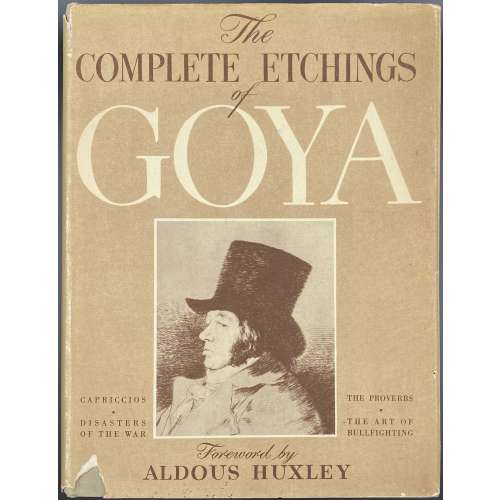 Title: THE COMPLETE ETCHINGS OF | Goya | With a Foreword by Aldous Huxley | CROWN PUBLISHERS. NEW YORK|| Pagination: [2 blank] [1-6] 7-16 [6], 234 plates on 118 leaves [2 blank] Contents: The capriccios [Los caprichos]. The disasters of the war [Los desastres de la guerra]. The art of bullfighting [La Tauromaquia]. The proverbs [Los disparates, Proverbios]. Miscellany. Binding: Hardcover, grey cloth, black lettering to cover and spine, pictorial DJ.
Title: THE COMPLETE ETCHINGS OF | Goya | With a Foreword by Aldous Huxley | CROWN PUBLISHERS. NEW YORK|| Pagination: [2 blank] [1-6] 7-16 [6], 234 plates on 118 leaves [2 blank] Contents: The capriccios [Los caprichos]. The disasters of the war [Los desastres de la guerra]. The art of bullfighting [La Tauromaquia]. The proverbs [Los disparates, Proverbios]. Miscellany. Binding: Hardcover, grey cloth, black lettering to cover and spine, pictorial DJ. -
![The erotic drawings of Mihály Zichy : Forty drawings. — New York: Grove Press Inc., 1969. — [2 intro.] + [40 ill.]](https://varshavskycollection.com/wp-content/uploads/2021/02/LIB-2244.2019-2-scaled-500x500.jpeg) Description: Oblong volume, 22 x 27 cm, quarter cloth over marbled boards with gilt Zichy’s signature fac-simile and gilt lettering to spine in dust jacket lettered “The | Erotic | Drawings | of | Mihály | Zichy” on both front and back, blurbs on flaps, unclipped; printed on wove paper, unpaginated. Title-page: THE EROTIC DRAWINGS | OF | MIHÁLY ZICHY | Forty drawings | GROVE PRESS INC. | NEW YORK || Collation: (1) h.t., (1) t.p./copyright, (1) Preface; (40) leaves of plates, (1) blank; total 44 leaves. The plates are photomechanical offset copies made from the photogravures of 1911 Leipzig private press edition [SVE-0501.2021] of 300 copies, the copy used for reprint was № 277; photogravures were made from the original watercolours and crayon drawings produced by Zichy in 1874-1879; the original album of 51 compositions was sold at Christie’s sale of Gérard Nordmann collection on December 14-15, 2006 in Paris. Ref.: Bibliothèque érotique: Gérard Nordmann; Livres, manuscrits, dessins, photographies du XVIe au XXe siècle / Catalogues de ventes, seconde partie. — Paris: Christie's, 2006; p. 280, № 564 (drawings); № 565 photogravures [LIB-2810.2021]. See a copy of the Leipzig album № 285 in this collection [SVE-0501.2021].
Description: Oblong volume, 22 x 27 cm, quarter cloth over marbled boards with gilt Zichy’s signature fac-simile and gilt lettering to spine in dust jacket lettered “The | Erotic | Drawings | of | Mihály | Zichy” on both front and back, blurbs on flaps, unclipped; printed on wove paper, unpaginated. Title-page: THE EROTIC DRAWINGS | OF | MIHÁLY ZICHY | Forty drawings | GROVE PRESS INC. | NEW YORK || Collation: (1) h.t., (1) t.p./copyright, (1) Preface; (40) leaves of plates, (1) blank; total 44 leaves. The plates are photomechanical offset copies made from the photogravures of 1911 Leipzig private press edition [SVE-0501.2021] of 300 copies, the copy used for reprint was № 277; photogravures were made from the original watercolours and crayon drawings produced by Zichy in 1874-1879; the original album of 51 compositions was sold at Christie’s sale of Gérard Nordmann collection on December 14-15, 2006 in Paris. Ref.: Bibliothèque érotique: Gérard Nordmann; Livres, manuscrits, dessins, photographies du XVIe au XXe siècle / Catalogues de ventes, seconde partie. — Paris: Christie's, 2006; p. 280, № 564 (drawings); № 565 photogravures [LIB-2810.2021]. See a copy of the Leipzig album № 285 in this collection [SVE-0501.2021]. -
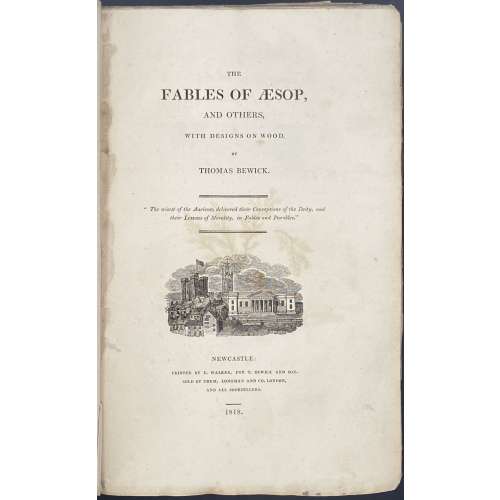 Title: THE | FABLES OF ÆSOP, | AND OTHERS, | WITH DESIGNS ON WOOD, | BY | THOMAS BEWICK. | “The wisest of the Ancients delivered their Conceptions of the Deity, and their Lessons of Morality, in Fables and Parables.” | {vignette} | NEWCASTLE: | PRINTED BY E. WALKER, FOR T. BEWICK AND SON. | SOLD BY THEM, LONGMAN AND CO. LONDON, AND ALL BOOKSELLERS. | 1818. || Pagination: [2] – blank / receipt with thumbprint, [i, ii] – t.p. / blank, [iii] iv-xvi – introduction with “Auld Clouty” vignette, [xvii] xviii-xxiv – table of contents, [1] 2-376; 188 wood-engraved head-pieces to the fables and 136 other vignettes, tail-pieces, etc. Collation: demy 8vo( octavo in fours); π1 (receipt), a-c4, B-3B4; A and 2P2 unsigned. Binding: Original blue boards, rebacked, original spine laid down, with original paper spine label ("Demy Paper/Price 15 s."); wove paper, top edge trimmed, the others are not; round book-plate to front paste-down “TWM, The Whitehead Library”; in a clamshell case, also book-plated inside. Size: case: 24.2 x 16.2 cm; boards: 22.8 x 14.2 cm; 22 x 14 cm. Note from seller: First copy in boards to ever appear at auction. Edition: First edition (one of 1,000 copies printed in demy 8vo), with Bewick's thumbprint and signature in facsimile, “Demy” and “15” in manuscript on receipt (page facing title-page), variant A (with "Auld Clouty" wood-engraving at bottom of p. XVI, and with the last line in p. 248 reading "road of honour and honesty"). "According to Roscoe, demy 8vo copies were apparently the first to be issued". There is 1 copy at the University Library, Cambridge and 1 at Liverpool public libraries. Catalogue raisonné: Roscoe: pp. 155-165, 45c for Variant A [see LIB-2714.2021]; Hugo (I vol.): p. 261; Ray: p. 35; Steedman: №№ 99-104, pp. 34-35 (№ 103 for Variant A).
Title: THE | FABLES OF ÆSOP, | AND OTHERS, | WITH DESIGNS ON WOOD, | BY | THOMAS BEWICK. | “The wisest of the Ancients delivered their Conceptions of the Deity, and their Lessons of Morality, in Fables and Parables.” | {vignette} | NEWCASTLE: | PRINTED BY E. WALKER, FOR T. BEWICK AND SON. | SOLD BY THEM, LONGMAN AND CO. LONDON, AND ALL BOOKSELLERS. | 1818. || Pagination: [2] – blank / receipt with thumbprint, [i, ii] – t.p. / blank, [iii] iv-xvi – introduction with “Auld Clouty” vignette, [xvii] xviii-xxiv – table of contents, [1] 2-376; 188 wood-engraved head-pieces to the fables and 136 other vignettes, tail-pieces, etc. Collation: demy 8vo( octavo in fours); π1 (receipt), a-c4, B-3B4; A and 2P2 unsigned. Binding: Original blue boards, rebacked, original spine laid down, with original paper spine label ("Demy Paper/Price 15 s."); wove paper, top edge trimmed, the others are not; round book-plate to front paste-down “TWM, The Whitehead Library”; in a clamshell case, also book-plated inside. Size: case: 24.2 x 16.2 cm; boards: 22.8 x 14.2 cm; 22 x 14 cm. Note from seller: First copy in boards to ever appear at auction. Edition: First edition (one of 1,000 copies printed in demy 8vo), with Bewick's thumbprint and signature in facsimile, “Demy” and “15” in manuscript on receipt (page facing title-page), variant A (with "Auld Clouty" wood-engraving at bottom of p. XVI, and with the last line in p. 248 reading "road of honour and honesty"). "According to Roscoe, demy 8vo copies were apparently the first to be issued". There is 1 copy at the University Library, Cambridge and 1 at Liverpool public libraries. Catalogue raisonné: Roscoe: pp. 155-165, 45c for Variant A [see LIB-2714.2021]; Hugo (I vol.): p. 261; Ray: p. 35; Steedman: №№ 99-104, pp. 34-35 (№ 103 for Variant A). -
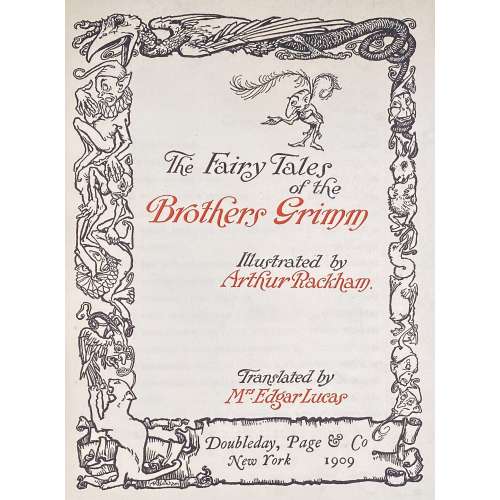 Title (black and red in pictorial frame): The Fairy Tales | of the | Brothers Grimm | Illustrated by Arthur Rackham. | Translated by | Mrs. Edgar Lucas | Doubleday, Page & Co | New York 1909. Pagination: [i-iv] – h.t., t.p., frontis., v-xv [xvi], 1-325 [326] colophon., [1 blank sheet], bfl; 40 tipped-in color plates (offset chromolithograph) with lettered guards, numerous in-text woodcuts. Collation: 4to; a-b4, A-2S4. Edition: 1st deluxe American large-paper edition, limited to 50 copies, Rackham’s facsimile signature to h.t. verso. Binding: Original full limp suede binding with yapp edges, gilt-ornamented and lettered spine. Top edge gilt, other uncut. Moiré endpapers. Printed on laid paper. Marbled endpapers.
Title (black and red in pictorial frame): The Fairy Tales | of the | Brothers Grimm | Illustrated by Arthur Rackham. | Translated by | Mrs. Edgar Lucas | Doubleday, Page & Co | New York 1909. Pagination: [i-iv] – h.t., t.p., frontis., v-xv [xvi], 1-325 [326] colophon., [1 blank sheet], bfl; 40 tipped-in color plates (offset chromolithograph) with lettered guards, numerous in-text woodcuts. Collation: 4to; a-b4, A-2S4. Edition: 1st deluxe American large-paper edition, limited to 50 copies, Rackham’s facsimile signature to h.t. verso. Binding: Original full limp suede binding with yapp edges, gilt-ornamented and lettered spine. Top edge gilt, other uncut. Moiré endpapers. Printed on laid paper. Marbled endpapers. -
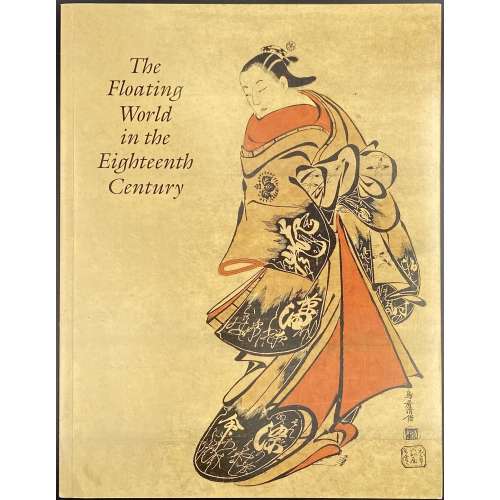 Softcover, in pictorial wrappers, 28 x 21.7 cm, 25 entries, with colour illustrations, some folding. Catalogue of the sales exhibition on March 28 -April 7, 2006, in NY; pagination: [2] 3-61 [62 blank [2], ils. Contributor: Sebastian Izzard
Softcover, in pictorial wrappers, 28 x 21.7 cm, 25 entries, with colour illustrations, some folding. Catalogue of the sales exhibition on March 28 -April 7, 2006, in NY; pagination: [2] 3-61 [62 blank [2], ils. Contributor: Sebastian Izzard -
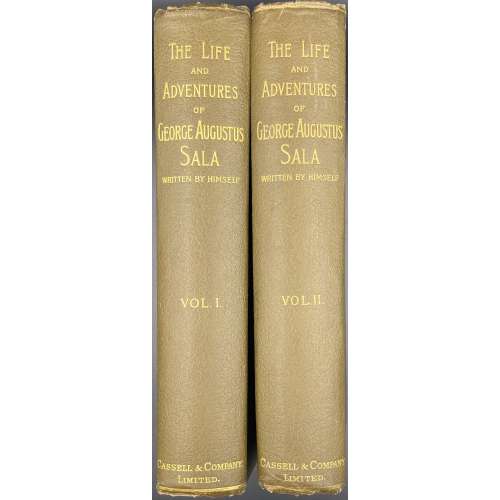 Vol. 1. Title: THE | LIFE AND ADVENTURES | OF | George Augustus Sala | WRITTEN BY HIMSELF | In Two Volumes | VOL. I. | (WITH PORTRAIT OF THE AUTHOR) | CASSEL AND COMPANY, Limited | LONDON, PARIS & MELBOURNE | 1895 | ALL RIGHTS RESERVED || Pagination: frontispiece portrait of Sala by Boussod, Valadon & Cie. w/guard tissue, [i, ii] – t.p./blank, [iii, iv] – dedication/blank, [v]-x – preface, [xi]-xvi – content, [1] 2-442, [16] advert. Collation: A-Z8 AA-BB8 CC5 [Advert.]8. Vol. 2. Title: THE | LIFE AND ADVENTURES | OF | George Augustus Sala | WRITTEN BY HIMSELF | In Two Volumes | VOL. II. | (WITH PORTRAIT OF THE AUTHORS MOTHER) | CASSEL AND COMPANY, Limited | LONDON, PARIS & MELBOURNE | 1895 | ALL RIGHTS RESERVED || Pagination: frontispiece portrait of Sal’s mother w/guard tissue, [i, ii] – t.p. / blank, [iii] iv-viii – content, [1] 2-457-[460], [16] advert. Collation: A-Z8 aa-cc8 dd6 [Advert.]8. Binding: two volumes in uniform green publisher’s pebbled buckram, gilt lettering to spine, contemporary newspaper clippings to front and back pastedowns, vol. 2 uncut. Note: George Augustus Sala's mother was an actress Henrietta Simon Sala, known as Madame Sala, (Guyanese, British, 1789 – 1860). Here she is depicted by an engraver Thomas Alfred Woolnoth (British, 1785 – 1857) after a portrait painted by Rose Emma Drummond (British, fl. 1820 – 1840).
Vol. 1. Title: THE | LIFE AND ADVENTURES | OF | George Augustus Sala | WRITTEN BY HIMSELF | In Two Volumes | VOL. I. | (WITH PORTRAIT OF THE AUTHOR) | CASSEL AND COMPANY, Limited | LONDON, PARIS & MELBOURNE | 1895 | ALL RIGHTS RESERVED || Pagination: frontispiece portrait of Sala by Boussod, Valadon & Cie. w/guard tissue, [i, ii] – t.p./blank, [iii, iv] – dedication/blank, [v]-x – preface, [xi]-xvi – content, [1] 2-442, [16] advert. Collation: A-Z8 AA-BB8 CC5 [Advert.]8. Vol. 2. Title: THE | LIFE AND ADVENTURES | OF | George Augustus Sala | WRITTEN BY HIMSELF | In Two Volumes | VOL. II. | (WITH PORTRAIT OF THE AUTHORS MOTHER) | CASSEL AND COMPANY, Limited | LONDON, PARIS & MELBOURNE | 1895 | ALL RIGHTS RESERVED || Pagination: frontispiece portrait of Sal’s mother w/guard tissue, [i, ii] – t.p. / blank, [iii] iv-viii – content, [1] 2-457-[460], [16] advert. Collation: A-Z8 aa-cc8 dd6 [Advert.]8. Binding: two volumes in uniform green publisher’s pebbled buckram, gilt lettering to spine, contemporary newspaper clippings to front and back pastedowns, vol. 2 uncut. Note: George Augustus Sala's mother was an actress Henrietta Simon Sala, known as Madame Sala, (Guyanese, British, 1789 – 1860). Here she is depicted by an engraver Thomas Alfred Woolnoth (British, 1785 – 1857) after a portrait painted by Rose Emma Drummond (British, fl. 1820 – 1840). -
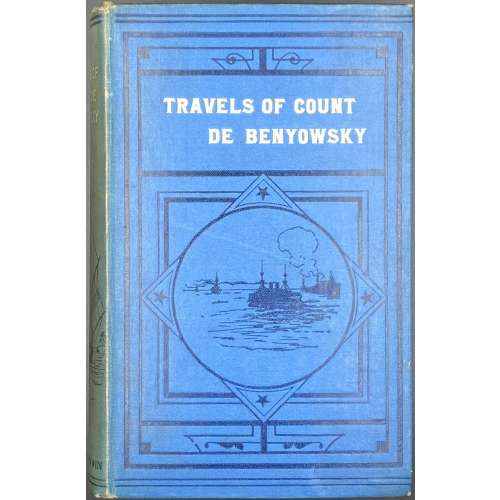 Hardcover volume in 8vo, 20.4 x 13.7 cm, blue cloth with black pictorial stamping and white embossed lettering to front cover and spine, spine sunned, head and tail frayed. Title-page: ❦❦❦ THE MEMOIRS AND | TRAVELS OF MAURITIUS | AUGUSTUS COUNT DE | BENYOWSKY ❦❦❦ | IN SIBERIA, KAMCHATKA, JAPAN, | THE LIUKIU ISLANDS AND FORMOSA | FROM THE TRANSLATION OF HIS | ORIGINAL MANUSCRIPT (1741–1771), | BY WILLIAM NICHOLSON, F.R.S., 1790 | EDITED BY CAPTAIN | PASFIELD OLIVER | ILLUSTRATED | LONDON: T. FISHER UNWIN, | PATERNOSTER SQUARE. MDCCCXCVIII || Collation/Pagination: [1]7 2-258; blue advertisement sheet laid in. [1, 2] – serial h.t. "The Adventure Series" / advert. THE ADVENTURE SERIES. Illustrated. Popular Re-issue, large cr. 8vo, 3s. 6d. 8 titles, [3, 4] – t.p. / blank, [5] 6-9 contents, [10] blank, [11, 12] missing, [13] 14-52 introduction, 53-399, [400] colophon: THE GRESHAM PRESS, | URWIN BROTHERS, | WORKING IN LONDON. Total number of leaves 199; 398 pages; one leaf of the first gathering missing (pp. 11/12 list of illustrations. No illustrations in this volume. Compared to another copy of the same edition, LIB-2701.2021, besides the binding: no list of illustrations, no illustrations, different colophon, different advertisement, slightly different h.t. Contributors: Publisher: T. Fisher Unwin (London); Thomas Fisher Unwin (British, 1848 – 1935). Author: Maurice Auguste count de Benyowsky [Мориц Август Бенёвский] (Polish-Slovak-Hungarian, 1746 –1786). Editor: Samuel Pasfield Oliver (British, 1838 – 1907). Translator: William Nicholson (British, 1753 – 1815). Originally published in 1790, in London (I have not seen it anywhere) and in Dublin by P. Wogan [etc.], and in 1791 in French, in Paris by Buisson; see LIB-2742.2021. For the 1904 edition, see LIB-2703.2021.
Hardcover volume in 8vo, 20.4 x 13.7 cm, blue cloth with black pictorial stamping and white embossed lettering to front cover and spine, spine sunned, head and tail frayed. Title-page: ❦❦❦ THE MEMOIRS AND | TRAVELS OF MAURITIUS | AUGUSTUS COUNT DE | BENYOWSKY ❦❦❦ | IN SIBERIA, KAMCHATKA, JAPAN, | THE LIUKIU ISLANDS AND FORMOSA | FROM THE TRANSLATION OF HIS | ORIGINAL MANUSCRIPT (1741–1771), | BY WILLIAM NICHOLSON, F.R.S., 1790 | EDITED BY CAPTAIN | PASFIELD OLIVER | ILLUSTRATED | LONDON: T. FISHER UNWIN, | PATERNOSTER SQUARE. MDCCCXCVIII || Collation/Pagination: [1]7 2-258; blue advertisement sheet laid in. [1, 2] – serial h.t. "The Adventure Series" / advert. THE ADVENTURE SERIES. Illustrated. Popular Re-issue, large cr. 8vo, 3s. 6d. 8 titles, [3, 4] – t.p. / blank, [5] 6-9 contents, [10] blank, [11, 12] missing, [13] 14-52 introduction, 53-399, [400] colophon: THE GRESHAM PRESS, | URWIN BROTHERS, | WORKING IN LONDON. Total number of leaves 199; 398 pages; one leaf of the first gathering missing (pp. 11/12 list of illustrations. No illustrations in this volume. Compared to another copy of the same edition, LIB-2701.2021, besides the binding: no list of illustrations, no illustrations, different colophon, different advertisement, slightly different h.t. Contributors: Publisher: T. Fisher Unwin (London); Thomas Fisher Unwin (British, 1848 – 1935). Author: Maurice Auguste count de Benyowsky [Мориц Август Бенёвский] (Polish-Slovak-Hungarian, 1746 –1786). Editor: Samuel Pasfield Oliver (British, 1838 – 1907). Translator: William Nicholson (British, 1753 – 1815). Originally published in 1790, in London (I have not seen it anywhere) and in Dublin by P. Wogan [etc.], and in 1791 in French, in Paris by Buisson; see LIB-2742.2021. For the 1904 edition, see LIB-2703.2021.


